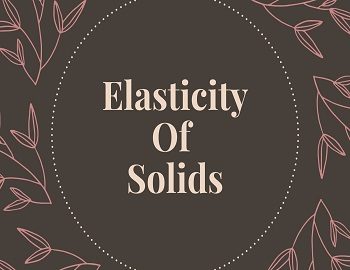Elasticity Of Solids:
Our universe is composed of matter and radiant energy. Matter is defined as anything which occupies space and possesses weight. We know that matter is made up of tiny particles referred to as molecules. The molecules have very small mass and, thus, cannot be seen. The molecules of different substances have different molecular masses. As a matter of fact, there is a gap between the molecules and there are attractive forces between the molecules.
Matter exists in three states namely solid, liquid and gaseous. The forces of attraction between the molecules of a solid, liquid and gas are not uniform but are different. In a solid substance, the molecules have strong forces of attraction so they are held together very close to one another and hence, the movements of molecules are limited. Solid substances are hard and cannot be compressed to a large extent. Hence, solids have a definite shape and a definite volume. Wood, glass, stone, iron, gold and sand are some instances of solid substances.
On the other hand, in liquids, the molecules are held together less firmly by weak attractive forces and thus, can be compressed more than the solids. This enables them to slide over one another easily and take the shape of the container in which they are placed. Hence, liquids have a definite volume but no definite shape of their own. Water, oil, alcohol, milk and ether are some instances of liquid substances.
In gases, the forces of attraction between the molecules are negligible in comparison to solids or even liquids. The molecules of gases have much greater mobility and they get separated widely from one another. As a matter of fact, the gases assumed the shape and volume of the container. Further, gases can be compressed easily because there is enough space between the molecules. Hence, gases have no definite shape and volume. Hydrogen, oxygen, nitrogen, chlorine, carbon dioxide and sulfur dioxide are some instances of gaseous substances.
The solid substances have different characteristics. They have a definite shape of their own which they intend to retain. Some solids are elastic, some are plastic, while some are brittle in nature. Some solids are crystalline while the other is amorphous in nature. Evidently, the study of solids is very interesting.
All solid bodies get deformed under the influence of a force. No solid is perfectly rigid, all of them do undergo some change in shape or size when subjected to external deforming forces. A body whose shape, size and volume do not change under the influence of a large force is referred to as the perfectly rigid body. There is not a single known body which is perfectly rigid in nature. For all practical purposes, the solid is considered to be rigid in nature.
Consider the behaviour of some substances subjected to the action of external deforming forces. Take a rubber ball and press it. The ball gets deformed. Similarly, beat a piece of iron with the help of a hammer. It also gets deformed. A strip of steel can be bent by applying a force on it. A spring may be compressed or stretched by compressing or pulling it. On removing the deforming forces, all bodies come back to their original shape, provided the distortion is not too great. A body which completely regains its original shape, after the removal of the external deforming force, is referred to as the elastic body. Some examples of elastic bodies are rubber, steel, spring etc.
The property of a body by virtue of which a body tends to return to its original shape and size after the deforming forces cease to act on it is known as elasticity. Thus, elasticity is the property of matter by virtue of which a substance or body regains its original shape, size or volume completely and immediately on the removal of deforming forces. There is no material which is perfectly elastic in nature. The nearest approach to a perfectly elastic body is the quartz fibre. The rubber is less elastic than steel.
On the other hand, we have substances or bodies like chewing gum, lead solder, putty, plasticine, damp clay etc. which get permanently deformed under the influence of small forces. These are referred to as plastic or inelastic bodies. A body which does not regain its original shape and size after the deforming forces cease to act on it is known as the plastic body. The property of matter by virtue of which a body retains its altered shape and size when the deforming forces are removed is referred to as plasticity. Thus, plasticity is a property opposite to elasticity. A body is considered to be perfectly plastic if it entirely retains its altered shape and size on the removal of deforming forces. Again, there is no material or body which is perfectly plastic in nature. All bodies exhibit a behaviour intermediate between perfect elasticity and perfect plasticity.









Comments (No)